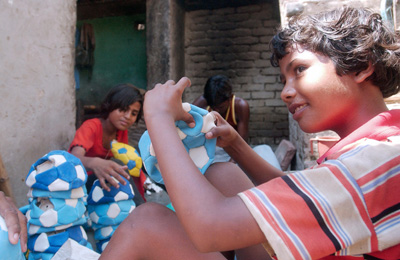Revolution #145, October 19, 2008
Soccer Balls Made in India
Childhood Lost
Each year, India produces more than one million hand-stitched soccer balls, most of which are exported for sale to nations around the world, including the United States. In some of the poorest areas of the country, children as young as six play a part in that industry, spending their days tediously sewing soccer balls together with little hope of a better life. The fortunate ones are paid cents a day for their work; the rest see nothing at all, because they’ve been sold into debt bondage and are forced to work as indentured servants.
From: Episode 138 of Real Sports with Bryant Gumbel
From a Reader
The beginning of the Constitution of the Revolutionary Communist Party, USA poses reasons why…“The world today cries out for radical fundamental change.” One of those reasons is a “…world where the lives of countless children are ground up and destroyed, some as child laborers and even outright slaves, others as victims of poverty and humiliation…their potential crushed, or their lives cut short.” A graphic documentation of this entire statement can be seen this month on HBO’s Real Sports with Bryant Gumbel segment, “Children of Industry,” where children in India are “ground up” in the “meat grinder” international soccer ball industry.
 |
| Indian children who used to work protest against child labor in the manufacturing of soccer balls in New Delhi, India, May 31, 2002. AP Photo |
“Children of Industry” shows how thousands of children in India, as young as age 6, work for up to 15 hours a day, crouching on dirt floors, stitching soccer balls for five cents an hour or nothing at all. One 12-year-old girl is paid 15 cents for a ball that sells in the U.S. for $15. She tells of having back aches due to being hunched over all day, and her eyes hurt from finding the small holes to thread the string. Children regularly cut their fingers cutting the string with a sharp implement.
There’s the heart-rending story of a 10-year-old boy—when his baby brother got sick his mother borrowed less than $100 from a soccer ball contractor for medicine. In order to pay off the loan, she exchanged her son’s labor to stitch soccer balls. The loan was made at an exorbitant rate and the loan has grown—now her son can’t even make enough soccer balls to pay down the loan, which means he will be a debt slave for an indefinite period of time. You learn that sometimes this debt is passed on—to other family members who then become slaves to pay off the debt. But in this case, the baby brother escapes this fate—because he is so sick that he dies.
 |
| Child workers in the Meerut District of Uttar Pradesh in Northern India stitch soccer balls which are sold worldwide. Photo: Manpreet Romana/AFP/Getty Images |
The soccer balls made by child labor in India are made for over 10 international companies, including Mitre, whose soccer balls are used by the U.S. pro soccer league and by the most prestigious soccer league in the world, England’s Premier League.
The soccer industry, from the sporting companies, to the U.S. government, to the stores that sell the balls, all officially prohibit the use of child labor, and there is wide-spread denial that children are used to make these soccer balls. Despite these claims of no child labor, Real Sports with Bryant Gumbel traced the UPC codes of the balls made by children in India to balls sold by Walmart in the U.S. All those balls have a label on them that states, “Child labour free production.” Who stitched on those labels? Children!
People who have watched this segment of Real Sports with Bryant Gumbel are blogging all over the Internet, expressing horror and anger at what they have seen on this show. Everyone should check this out on HBO on Demand all this month (it is available until October 27). (Also, see “Offside: Child Labour in Football Stitching: A Case Study of Meerut District in Uttar Pradesh,” which can be found at bba.org.in.)
If you like this article, subscribe, donate to and sustain Revolution newspaper.



